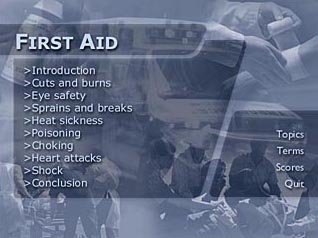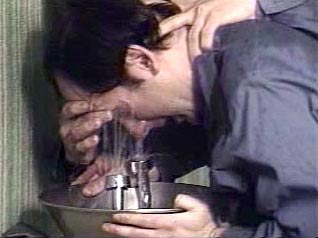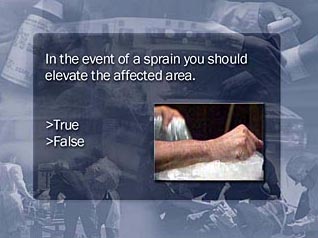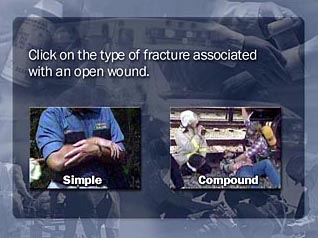Back to Course List
First Aid: Workplace First Aid

- Product ID
- smaxfaid
- Training Time ?
- 39 to 58 minutes
- Language(s)
- English
- Video Format
- Standard Definition
- Required Plugins
- MasteryNet Player
- Lesson Interactions
- 20
- Quiz Questions
- 40
- Closed Captioning



Overview
First Aid Training
This Course provides valuable information on the various types of common injuries that can occur, and the types of First Aid treatment appropriate to each one. You will also learn some basic First Aid techniques that can be used in these situations.
![]() This course is in the Advantage™ format, to read about Advantage™ features click here.
This course is in the Advantage™ format, to read about Advantage™ features click here.

- Rich multimedia presentation with interactions and quiz
- Print certificate and wallet card
- You have 30 days to complete the course
Audience
Training for all workers.
Topics
The course presents the following topical areas:
-
Cuts and Burns
- Cuts are a common workplace injury
- Some cuts can be more serious than others
- Blisters
- Burns
- Chemical burns
-
Eye Safety
- Chemical contact with eyes
- Simple eye injuries
- Severe eye injuries
- Black eye
-
Sprains and Breaks
- Muscle injuries in work environments
- First aid for strains and sprains
- Simple fractures are the most common
- Compound fractures
-
Heat Sickness
- Heat Stroke the most severe heat related injury
- Heat stroke requires immediate action
- Preventing the body from overheating
-
Poisoning
- Poisons can also be a workplace hazard
- Certain drugs can have ill effects
- Call the Poison Contrtol Center
-
Choking
- Choking
- The Heimlich Maneuver
-
Heart Attacks
- Heart attacks on the job
- Recognizing the symptoms of a Heart attack
- Act immediatly if you suspect a Heart attack
-
Shock
- Shock
- Shock can often worsen
Intended Performance Outcomes
Upon successful completion of this course you will be better prepared to:
-
Use proper first aid on cuts, blisters, and burns.
- Select proper procedure for treating cuts.
- Name the shot needed if someone is cut with a rusty object.
- Select proper procedure for treating blisters.
- Select proper procedure for treating burns.
- Analyze first aid for chemical burns.
- Describe actions that can make a burn worse.
-
Properly treat eye injuries.
- Distinguish proper procedures if an object is embedded in the eye.
- List treatment for a black eye.
- Choose safe removal of a particle stuck under the eyelid.
- Select proper procedure to follow if eyes come in contact with a chemical.
- Name the best way to protect eyes from harm.
-
Use proper first aid procedures on sprains, strains, broken bones, and fractures.
- Explain how muscular strains and sprains occur.
- Describe proper first aid treatment for muscle injuries.
- Describe proper first aid treatment for bone fractures.
- Recall the best way to move a person with a compound fracture.
-
Treat heat stroke and heat stress.
- Describe heat stroke.
- List steps to follow when treating heat stroke.
- Recall the possible results of heat stroke.
- Recognize improper treatment of heat stroke.
- Explain the importance of drinking fluids on a hot day.
-
Provide first aid to persons exposed to toxins and poisons.
- Agree that poisons can enter the body through various routes of entry.
- List precautions to follow when taking medicine.
- Identify steps to take if you suspect poisoning has occurred.
-
Rescue a choking victim.
- Recognize the possible outcomes of choking.
- Choose the type of thrusting motion when using the Heimlich maneuver.
- Agree to first call for help before starting the Heimlich maneuver.
- Explain how the Heimlich maneuver works.
- Select the danger of using upper arms when performing the Heimlich maneuver.
-
Provide first aid to someone having a heart attack.
- Describe a cardiac arrest.
- List symptoms of a heart attack.
- Recognize when to use rescue breathin g or CPR.
- Explain what causes a heart attack.
- Select the recommended first aid for a suspected heart attack victim.
-
Properly manage shock.
- Identify when shock occurs.
- Explain the importance of comforting a shock victim.
- List recommended first-aid treatment for a shock victim.
- Define shock.
© Mastery Technologies, Inc.



